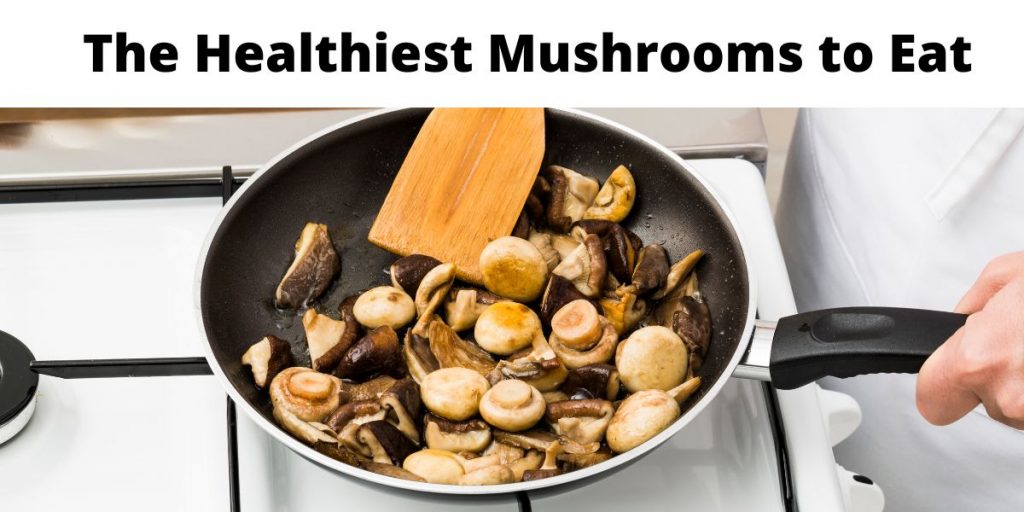Which are the healthiest mushrooms to eat? That’s a difficult question. For one thing, there are many different ways for food to be healthy. Some of those ways even contradict each other. For example, while we are used to calling low-calorie foods healthy, some people have trouble keeping their weight up and must choose calorie-dense foods. The reality is that any food that helps a person be healthy is a healthy food, and different people need different things.
That being said, certain mushrooms can be part of a healthy diet for many people. So let’s talk about the health benefits of eating particular kinds of mushrooms—and let’s talk about what makes a mushroom healthy to eat t begin with.

My name is Austin Collins.
I've dedicated my life to Mushrooms.
I believe Mushrooms are the best kept secret when it comes to health and well being.
For that reason, I would like to share a company with you that in my opinion makes the best mushroom products on the market.
The company is called Noomadic Herbals, my favorite supplement they make is called "Mushroom Total".
I take their products every day and they have helped me think better and have more energy. Give them a try.
-Austin
What Makes Mushrooms Healthy?
Basically, there are three ways that we can mean when we say a mushroom is healthy to eat. We can mean the mushroom isn’t unhealthy to eat—it’s not poisonous. Or we can mean the mushroom has a lot of nutrients. Or we can mean the mushroom has medicinal qualities. Let’s look at each of these, as they aren’t quite as straight-forward as they seem.
Healthy as Opposed to Unhealthy
While it might seem obvious that a healthy mushroom is one that won’t make you sick, there is a surprisingly long list of mushroom species, including some choice edibles, such as morels, that are commonly eaten and yet occasionally make at least a few people sick.
There are various reasons for these problems, some of which we don’t even know yet, and most of these species are perfectly fine to eat in moderation. But when putting together a list of the “healthiest mushrooms,” perhaps the first thing to do is to remove the questionably edible species from the list.
Virtually all mushrooms must be cooked to be digestible, and anything can trigger an allergy for somebody, but when we’re looking for the healthiest mushrooms, we mean mushrooms we can eat to our hearts’ content.
Healthy Bursting with Nutrients
Mushrooms are a low-calorie food, thanks to their high water content. If you like to eat and don’t want to gain weight, mushrooms will help you out. But that high water content makes it a little tricky to determine the nutritive value of mushrooms in other respects.
On a per-calorie basis, many mushrooms can be said to provide a full day’s supply of most micronutrients (vitamins and minerals) and a lot of protein. That means that if you ate enough of these mushrooms to meet your calorie needs for the day, you would also meet your needs for these other nutrients. That sounds great, until you consider that although the nutrient-to-calorie ratio is great, the total amounts of protein, vitamins, and minerals is very small—you’d have to eat several quarts of mushrooms a day for them to make a serious dent in your nutritional needs.
The important thing about mushrooms from a nutrition perspective is not that they are great sources anything you need. It’s that these are delicious foods where the more you eat, the better.
Healthy Like Medicine
Many mushrooms have a history of use in folk medicine, and modern research suggests that at least several may indeed be medically useful. As a result, the market is full of mushroom extracts marketed as health supplements.
Now, aside from the fact that in most cases the research has been preliminary only—few of these supplements have been tested for effectiveness in human patients. Remember that a mushroom is mostly water, and most of what isn’t water is fiber. That means that a fresh mushroom provides a very low dose of whatever medicinal substances it contains. With the major exception of the psychoactive species, few meals cooked with mushrooms are likely to deliver a medicinal dose of anything.
That doesn’t mean you can’t choose to cook with mushrooms thought to help with whatever your current struggle might be—as long as you look out for possible side effects, eating an extra serving of lion’s mane or whatever else won’t hurt and could conceivably support your other efforts towards better health, just don’t overestimate the strength of the effect involved.
What Are the Best Mushrooms to Eat for Your Health?
So, we’ve established that a healthy mushroom to eat can’t be borderline poisonous and should have lots of nutrients and maybe a medicinal substance or two, but it’s not going to rescue you from malnutrition or cure cancer. Eating mushrooms is not going to be a game-changer for your health (even if taking mushroom extracts could be), but they can be a small step in the right direction—and some mushrooms are that rare prize, something delicious that you really can’t eat too much of.
With that being said, let’s look at some of the species you can go ahead and indulge in. Please note that although I’m providing nutritional information per cup of raw mushrooms, mushrooms in general shouldn’t be eaten raw. They may also shrink in cooking due to water loss, so one cup raw is less than a cupful on the plate.
Domestic Mushrooms (Agaricus bisporus)
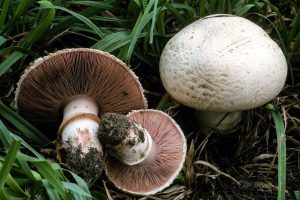
This species, which has no common name but “mushroom,” is the one most Americans are most familiar with as it is commonly sold in grocery stores, put on pizza, and so on. Both white and brown varieties exist. When immature, white mushrooms are sold as “white buttons,” while brown varieties are sold as “criminis.” Portabello mushrooms are simply the mature form of brown varieties. So this is one species but three different commercial products that differ slightly in flavor, texture, and nutritional profile.
These mushrooms do not go on the “healthiest” list when raw, as they contain significant amounts of agaritine, which is carcinogenic in mice[i]. Cooking thoroughly destroys most of the agaritine, however.
According to the USDA[ii], a cup of domestic mushrooms has about 20 calories and about three grams of protein and carbohydrate each. There is virtually no fat or sodium and no cholesterol. The mushrooms contain small amounts of several vitamins and minerals. We’ve found some other sources that claim a cup of these mushrooms have 22% of the daily recommended dose of vitamin D, and it may be that the vitamin D content varies; mushrooms, like humans, make more vitamin D when exposed to sunlight.
Oyster (Pleurotus ostreatus)
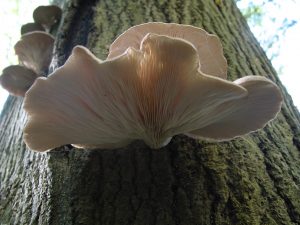
There are multiple related species in the oyster mushroom group, but this one is the best-known. The others may be similar. Oyster Mushrooms are considered safe to eat, but the spores can cause allergies among growers.
One cup of Oyster Mushrooms[iii] has almost 30 calories, with three grams of protein and five of carbohydrate. They contain almost no fat and no cholesterol. They are a good source of niacin (vitamin B3) and riboflavin (vitamin B2), providing about a fifth of the recommended daily dose of each, and smaller amounts of several other vitamins.
Oyster Mushrooms have been shown to have medicinal potential in several preliminary studies, but it’s not clear whether simply eating them as a normal part of the diet is helpful. It may be.
Maitake (Grifola frondosa)
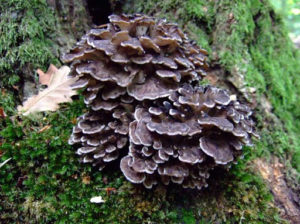
Maitake, also known as hen-of-the-woods (not to be confused with chicken-of-the-woods) looks a bit like a pile of gray chicken feathers and tastes good fried with cheese. Old specimens can become difficult to digest, but otherwise it can be eaten freely.
One cup[iv] has about 22 calories, 1.4 grams of protein, and almost five grams of carbohydrate. There is no cholesterol and almost no fat or sodium. Most micronutrients (vitamins and minerals) are present only in trace amounts if at all, but a single cup has almost double the vitamin D you need for the day.
Chanterelle (Cantharellus cibarius)
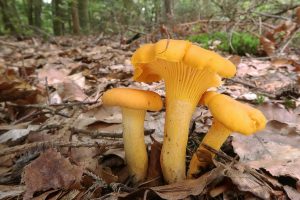
There are many species of Chanterelle, but C. cibarius was the first to bear the name and is usually the one people mean when they don’t otherwise specify. It is a European species, but has American look-alikes that reportedly taste quite similar.
A cup of Chanterelles, curiously, weighs just over half what a cup of domestic mushrooms does. If we were defining portion sizes by weight rather than by volume—say, providing information for 100 grams of each species—the comparison would look very different. But it is more difficult to get information for serving sizes defined by weight, and we wanted to be as consistent as possible.
A cup of chanterelles[v], then, has 17 calories, with less than a gram of protein and almost four grams of carbohydrate. There is almost no fat or sodium. The only micronutrient present in significant quantity is copper, with about a fifth of the daily recommended dose. Other micronutrients, such as vitamins D and B3, are present in smaller amounts.
Chanterelles are reputed to be among the world’s best mushrooms. When considering which mushrooms are healthiest, consider the role of pleasure in mental health. There, chants score high.
Shiitake (Lentinula edodes)
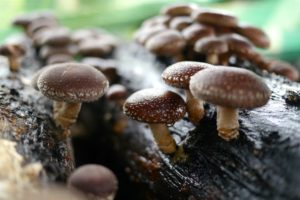
Shiitakes don’t belong on the healthiest mushroom list unless cooked; raw, they can sometimes cause a rash due to the presence of a substance called lentinan, which is destroyed by thorough cooking[vi]. Some wild strains can also cause mild illness, but cultivated Shiitakes appear to be fine if cooked. They have a firm, somewhat chewy texture and a mild taste. Freezing them and then thawing prior to cooking alters their texture such that they become a good substitute for clams in vegetarian chowder.
This time we found serving size only measured by weight—this is for 100 grams of raw Shiitake[vii]. It’s about a cup-worth. It’s got 34 calories, with just over two grams of protein and almost seven grams of carbohydrate. There is almost no fat or sodium. There is almost a third of a day’s supply of pantothenic acid (vitamin B5) and a quarter of a day’s supply of vitamin B3. Other micronutrients, such as vitamins B6 and B2 and copper, are present in smaller amounts.
References:
[i] Hashida, C., Hayashi, K., Jie, L., Haga, S. Sakurai, M. Shimizu, H. (1990). Quantities of Agaritine in Mushrooms (Agaricus bisporus) and the carcinogenicity of Mushroom Methanol Extracts on the Mouth Bladder Epithelium. Japanese Journal of Public Health 37(6): 400-5.
[ii] (n.d.). Mushrooms, White, Raw. US Department of Agriculture
[iii] Fray, M., Moore, M. (2021). Oyster Mushroom Nutrition Facts. VerywellFit
[iv] (n.d.). Mushrooms, Maitake, Raw. US Department of Agriculture
[v] (n.d.). Mushrooms, Raw, Chanterelle. Nutrition Value
[vi] (2021). ANSES and the DGCCRF Reiterate the Importance of Cooking Shiitake Mushrooms Thoroughly Before Eating to Avoid Poisoning. ANSES
[vii] (n.d.). Mushrooms, Raw, Shiitake. Nutrition Value

